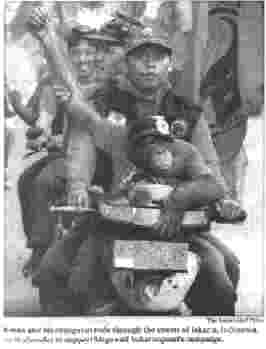| B A R E L Y B A D W E B S I T E |
|
Monkeys |

|
From the Kansas City Star of February 25,
2000: Killer monkeys NAIROBI, Kenya -- Thirsty monkeys in drought-affected Kenya
stoned to death a herder watering his livestock, a newspaper reported Thursday. |
|
I have a special liking for monkeys. If I ever decide it's always wrong to hurt certain non-human animals it will be our fellow primates, because they're damned smart. They're so close to being human compared to, say, dogs, that I fear our grandchildren will look back on us and wonder at how cruel we could be. I also kind of fear that in enough generations the monkeys themselves will look back on us and wonder the same thing. I have been around monkeys more than the average person. One summer when I was about 14 I was a helper at a Head Start school in the mornings (where I dealt with yard apes), and in the afternoons I did some volunteer work at the Swope Park Zoo. (Thanks, JNG, for that summer.) I shoveled my share of puma poop, and I got spat on more often than I would have preferred (tip if you have trouble distinguishing between a camel and a llama: camel spit is brown and watery, and llama spit is green and slimy), and I got spurred by the damned rooster a couple times, but what I also got was to be a docent. In that capacity I spent some of my time in the petting zoo, with kids and their parents and pygmy goats and ducks and lambs and rabbits. Sam and Dave. And I spent some of my time strolling around the zoo with Sam and Dave on my arms and my shoulders and my head. Sam and Dave were macaws, and they invariably attracted people's attention. The patrons would come over and watch them for a while, and maybe half would eventually ask whether they could pet them. I always said, "No, they bite." Now, they didn't bite me because I was taught how to handle them (the parrots, not the patrons) and because they knew me, but they would bite strangers. Whenever adults went ahead and reached to pet Sam or Dave, I'd let them; the ones who did get bitten always seemed really surprised and a little bit irritated. Jethro. And I spent some of my time in the rabbit enclosure, which is where Jethro was chained to a bar that ran from the hutch out to the north side of the fence. Jethro was a capuchin, an organ-grinder monkey. He was always really attentive to everything, and he liked to tease the rabbits. He'd climb around on me and look at the patrons, and take stuff from them, and groom my hair. He also spent way too much time masturbating, which caused no end of consternation among the parents trying to explain what Jethro was doing. Update of April 3, 2004: The cover story in today's edition of Science News, a superb weekly magazine about recent developments in science, is about the behavior of capuchin monkeys in a nature reserve in Costa Rica. Picking up in the second paragraph: Each day in the field, [primatologist Susan Perry] and her colleagues get to observe these [capuchins'] curious interactions, some of the quirkiest behavior in the animal kingdom. For example, one game begins when one monkey bites a clump of hair from another monkey's face. The two monkeys use their teeth to pass the clump back and forth, dropping a little hair each time. When the hair runs out, the game begins again. Below is a scan of the next paragraph.
Jimmie. But I also spent some of my time with Jimmie, and that was exquisite. When I knew him Jimmie was a one-year-old chimpanzee. As of 2008 Jimmie is 42. Yep, a chimpanzee, a member of a species that is in the running for
the title of "Second-Smartest Animal" and that already has the title of
"Second Most Human-Looking Creature" sewed up. |
 |
Here's a photo from the May 8, 2000, edition of The
Kansas City Star. The caption says, "Although they are separated by a heavy glass window, animal supervisor DiAnn Roberts is able to interact with Jimmie, the 34-year-old leader of the chimpanzee group."
|
|
Jimmie's cage was a half-cylinder lying on its side, like a Quonset hut with a skeleton but no walls, with a sunken floor and ropes to swing from, plus the classic accouterment, a tire. I would get in the cage with him, and it was so very fun, so exciting, and so fascinating. Whenever I went in there a crowd would gather, and Jimmie liked crowds. He was a show-off of the first order, a natural ham, and I, the human, was relegated to the position of bit player. No, not even bit player, more like prop. Although he was only a year old and maybe half my height and a fourth my weight, Jimmie was strikingly strong, especially in his arms. I know, because we wrestled a lot. I have no doubt that he could have snatched me across that cage and bashed me against the bars if he'd wanted to (see here for more information). Thankfully, he seemed to know his own strength, and only a couple times did I have to leave his house when his roughhousing got too rough. When I left he'd cry in his monkey way, and when I came back he'd be calmer for a while. Playing with Jimmie is one of the funnest things I have done, not because he was so playful but because he was so nearly human. Jimmie didn't move in short, jerky motions like a bird or even a capuchin. He moved like a human. Jethro the capuchin looked me in the eye, but for only a moment or two before he was off looking at something else. He was always jerking his head around like a restless robot. Jimmie the chimp looked me in the eye when I looked him in the eye, and I got the feeling he kind of meant it, as though he were searching for the right interpretation of my mien, like a human would. He had a remarkable range of facial expressions and noises, all of which were an exaggerated version of a human's. He'd pull his lips back and expose his teeth, he'd pout, and he'd smile; and he'd howl with pleasure and chatter with anticipation and giggle with silliness. He even produced a respectable raspberry, which always cracked up the crowd, so he'd do it again. Jimmie liked to touch me, and he liked me to touch him. As soon as I entered the cage he'd climb up onto my back and I'd ride him around. Unlike a human child, Jimmie was almost literally undroppable. No matter how abruptly I changed direction, Jimmie could always just reach out his very long arms and snatch a bar or a rope and swing free. We spent a lot of time with him jumping onto my back and hanging on for a bit and then leaping off to grab a bar or a rope, whence he would swing about and return to me and jump onto my back again. He'd move from place to place all over me, testing and grabbing whatever body part or piece of clothing made the most sense, like climbing a wall. And he was fast and good and sure at it. Sometimes -- when he got a little rough and I couldn't control him without getting a little rough myself -- I'd go sit down on the side of the cage. After a while he'd realize that I wasn't playing anymore, and he'd walk over and climb up onto my lap and settle down and just touch me. He'd put a finger on my cheek and draw a light line down to my chin, or he'd take my hand in his paw and draw that same light line on it with his other paw. Have you ever seen a chimp's paw up close? Whatever differences there are between a chimp's paw and a human's hand are trivial. A chimp's paw is not a paw, it is a hand. It is shaped like a human's, it is articulated like a human's, it has creases like a human's, and it has an opposable thumb.
Sometimes Jimmie would roost on my back and groom me. He'd pick through my hair with those oh-so-human-looking hands and every so often he'd run a strand through his lips. (No doubt I needed it, especially after Sam and Dave had been walking around on the top of my head.) In return I would pretend to groom him (except for the lips part), and that was when he was the calmest. Jimmie liked to be tickled, and when I obliged him he'd howl with what I can only call laughter. We spent a fair amount of time playing chase, mostly me chasing him. He'd get away and stop and chatter at me, and I'd take off after him. He would hoot and escape. When he eventually let me catch him I'd tickle him and, I'm telling you, you never saw a happier primate. It just now occurs to me that Jimmie never tried to tickle me to get me to laugh. I particularly enjoyed playing chase because I was so mesmerized by how effectively he could move. Between the bars on the outside and the ropes strung about inside, Jimmie could move anywhere in the cage without touching the ground, and he did it so very well, so effortlessly. Imagine the strongest, smoothest Olympic gymnast on the uneven parallel bars and the rings and the pommel horse that you've ever seen. Now -- and you need to stick with me here -- imagine his name is Bob. When they romp and swing about, one-year-old chimps are, I would say, roughly twice as strong and smooth as Bob. It is a remarkable performance, and you can get an appreciation of it from any number of nature documentaries. I wish I could express accurately how interesting Jimmie was to me. At first it was because he was like a really great dog, like a super pet. But after a short while I came to recognize that he was a lot smarter than that, more nearly human, more worthy of my consideration and my respect. I am all in favor of more people learning more about more animals, but in the case of an animal such as Jimmie I am not sure zoos are the right place. Update of July 9, 2008: My mom and my 14-year-old and a friend and I visited the zoo today, and when we got to the ape enclosure I mentioned to the docent that I had played with Jimmie in his cage when he was only a year old. She said, and I think she was serious, that Jimmie would likely recognize me! I can't say for sure that he did, but I like thinking it. Update of August 28, 2008: The headline on page B1 of today's Kansas City Star reads, "Zoo loses a familiar face in death of chimp." Here are two excerpts from that article about Jimmie. ● "Randy Wisthoff, zoo director, said, '[Jimmie] was fine and alert earlier in the morning, and at some point he went over and laid [sic] down, and that was it.'" ● "When [former zookeeper Jan] Armstrong visited the zoo to see Jimmie earlier this year, the chimp remembered her. 'He would come up to the window,' she said. 'The keepers could tell that he recognized me.'" Ms. Armstrong took care of infant animals when Jimmie arrived at the zoo, so maybe he really could remember me. I'm glad I had one last chance to see Jimmie. And he me.
|
 |
From the AP as reported in The Kansas City Star: Monkeys ransack KUALA LUMPUR, Malaysia -- A pack of wild monkeys raided a
health clinic in northeastern Malaysia, scaring patients and making off with medical
equipment, a park official said Wednesday. |
 |
The caption of this AP photo, which ran in The
Kansas City Star, is as follows:
I just generally like the idea of the phrase "A man and his orangutan," as though it were "A man and his dog." |
|
According to the caption, the man supports the campaign of Megawati Sukarnoputri, but, according to my reading, it also says the monkey supports it. Finally, if you take a moment to count you'll see that there appears to be one whole extra hand. OK, now really finally, does it surprise you that the candidate, who was elected president of a country whose population is almost as large as America's, is a female? |
|
 |
This is from The Kansas City Star of July 18, 2007. |
 |
And now, from the January 7, 1990, edition of The
Kansas City Star, here is one of my favorite newspaper articles of all time, not just
about monkeys but about anything:
Execution New Delhi, India -- A judge stayed the execution of a
"naughty monkey" and will consider a request from animal lovers to banish it to
a wildlife sanctuary, a newspaper reported Saturday. |
|
|
This article, from the November 15, 2008, edition of
The Kansas City Star, refers to a hilarious experiment conducted in
2003. You can learn more, and laugh harder, by going
HERE. The test used only six monkeys, but the question is whether an infinite number of monkeys could do it, i.e., produce all the works of Shakespeare, flawlessly, among all the other random garbage they'd type. If a monkey gets all the way up to the very last character of the last work without error, just by random chance, but then he types a comma instead of a period, that wouldn't count. So, could an infinite number of monkeys do it? The answer is indisputably Yes. Such an occurrence -- even if the monkeys could type many, many billions of trillions characters in a billionth of a trillionth of a nano-second -- would take many, many billions of trillions of millennia before one of them did it. And yet, with an infinite number of monkeys, not only would they type out all the works of Shakespeare perfectly, they would do it an infinite number of times. Similarly, if you had only one monkey but an infinite amount of time, that one monkey, all by himself, would eventually type out the works of Shakespeare perfectly. And he would do it not just once but an infinite number of times. Similarly, if you had only one monkey and less than a second, but the monkey could type infinitely fast, you'd get the same result: That one monkey, in way less than the blink of an eye, would type out not just one but an infinite number of flawless copies of the works of Shakespeare. So what if you combine the three? You have an infinite number of monkeys typing at an infinitely high rate of speed for an infinite amount of time. Can you cube infinity? If you like thinking about big numbers, see here. |
|
Click the chimp's face to go to PNAS.ORG, where you'll find articles with such riveting titles as these: "The Arabidopsis outward K+ channel GORK is involved in regulation of stomatal movements and plant transpiration"; "Specific protein methylation defects and gene expression perturbations in coactivator-associated arginine methyltransferase 1-deficient mice"; and "3D electron microscopy reveals the variable deposition and protein dynamics of the peripheral pyruvate dehydrogenase component about the core." Have fun! |
Here's a thought-provoking article from the May 20, 2003, edition of The Kansas City Star.
Chimp link WASHINGTON -- Chimpanzees are more closely related to people than to gorillas or other primates, and
probably should be included in the human branch of the family tree, a research team says. |
|
Life on Earth is categorizable in many ways, one of which is by the taxonomic divisions promulgated originally by Carolus Linnaeus, an 18th-century Swedish botanist. His system of classification -- now much improved but still not entirely standardized -- runs through seven levels of detail (called taxa) in describing the characteristics of a particular living thing. The highest classification is called a kingdom and the lowest is called a species. Here's a brief description of each one. Kingdom. The two most familiar kingdoms are plants and animals, but a few others exist. This level of classification contains little detail about the particular living thing in question, but it makes sense to distinguish between plants and animals before making any other distinctions. Henceforth we'll be discussing only the animal kingdom, and I have a particular animal in mind. Phylum. A distinction of interest at the phylum level is whether the animal has the essence of a spinal cord. The particular animal I have in mind does, i.e., it is a chordate. Animals without a spinal cord include oysters, earthworms, spiders, and insects. Class. Among the chordates are several classes: fish, reptiles, amphibians, birds and so on. The animal I have in mind is a mammal. Order. Among the class of mammals are several orders, for example, aardvarks, bats, cattle, dolphins and elephants. The order of the animal I'm thinking of is primate. Family. Among the order of primates are about a dozen families -- the lemurs, the gibbons, the baboons, the capuchins, and the pongids. The family I'm thinking of is the pongids, or hominids. Genus. There are only four genera in the hominid family: Pongo (orangutans), Gorilla (gorillas), Pan (chimpanzees and pygmy chimps), and Homo (man). Species. The species level of taxonomy is special in that only animals within the same species -- regardless of the genus or the family or the order or the class or the phylum or the kingdom -- can marry and have children. For example, a Chihuahua can impregnate an Alaskan Malamute (and -- at least theoretically -- vice versa), because they're both members of the same species. They're members of different breeds, but because they are genetically compatible they are members of the same species. If you are a typical reader of this Web site, it's you I'm thinking of. You are classified as a member of the hominid family. Within the family of hominids you are a member of the genus Homo. And within the genus Homo, there being only one species, you must be of the species sapiens. Here are some definitions that might help. Anthropoid Resembling a human; an ape member of the hominid family. Arthropod Not to be confused with anthropoid, an invertebrate animal characterized by an exoskeleton and a segmented body (arthr- means "joint") to which appendages are attached in pairs. Among the arthropods are beetles, butterflies, boll weevils and all the other insects, as well as centipedes, spiders, lobsters and barnacles. Arachnid An arthropod animal with four pairs of segmented legs and two body parts. Included are spiders and scorpions, but not beetles, butterflies or boll weevils. Insect An arthropod with three body segments, three pairs of legs, and usually two pairs of wings. Spiders, having four pairs of legs, two body segments and no wings, are not insects, but they are most certainly animals, as are birds. Great ape Orangutans, gorillas, and chimpanzees and bonobos; same as anthropoid ape. Ape Any large, tailless member of the family hominid. Compare to monkey. Hominid A member of the family hominid. Monkey Any long-tailed primate (excluding the anthropoids and the prosimians), examples of which are macaques, capuchins, and gibbons. Speaking of gibbons, I can tell you from my experience at the zoo I mentioned that their superhuman ability and willingness to harm humans were treated with a great deal of respect. Although I was allowed into the cages of the capuchin and the chimpanzee and even some of the smaller wildcats, the keepers made it quite clear I should stay far away from even the outside of the gibbon cage. The gibbons, maybe half a dozen of them, were quite an attraction every so often, and the rest of the time they weren't. Every hour or so they'd start whooping in this really loud voice -- all of them at once -- and it was eerie. They all sang the same whoop at the same time, as though each individual gibbon didn't think his voice alone was loud enough, which it was. Another feature of the gibbon cage was that if you got within too close of it they would reach through the bars and snatch you. Every so often someone would decide the best thing to do was stretch out really, really close to the cage with a peanut or something, and the nearest gibbon would take advantage of that tom-stupery by losing all interest in the peanut and grabbing the person's hand or arm or sleeve. And by letting out a particular vocal utterance that meant, "I've got another one!" Which resulted, in a matter of a few seconds, in the congregation of all the other gibbons so they could watch up close. Usually the patron pulled loose in time, but it was not unheard of for a gibbon to wham a patron's face up against the bars before losing his grip. Gibbons are altogether strong for their size compared to humans. And apparently they are just plain fierce, no matter which human they can get their hands on. I happened to be there the day the keepers moved the gibbons out of their summer cage to transport them to their winter quarters. They anastomosed the back end of a semi-trailer to one end of the cage and then forced the gibbons into it by squirting them with water. Primate A member of the order primate, including the anthropoids and prosimians. Prosimian A suborder of the primate order, including lemurs, lorises, and tarsiers. Sapient An adjective meaning "capable of wisdom." A species in the table of taxonomy, applicable only to the genus Homo. Homo sapiens is man. Simian An ape or monkey.
The current system of classification of the hominid family looks like this.
Goodman proposes that the chimps be promoted from a genus of Hominids to a species of Homo. Or would this be a demotion of Homo?
|
||||||||||||||||||||||||||||||
|
You can't really win $20 by clicking anything, I just like this monkey.
|
|
|
|
|
|
|
|
|